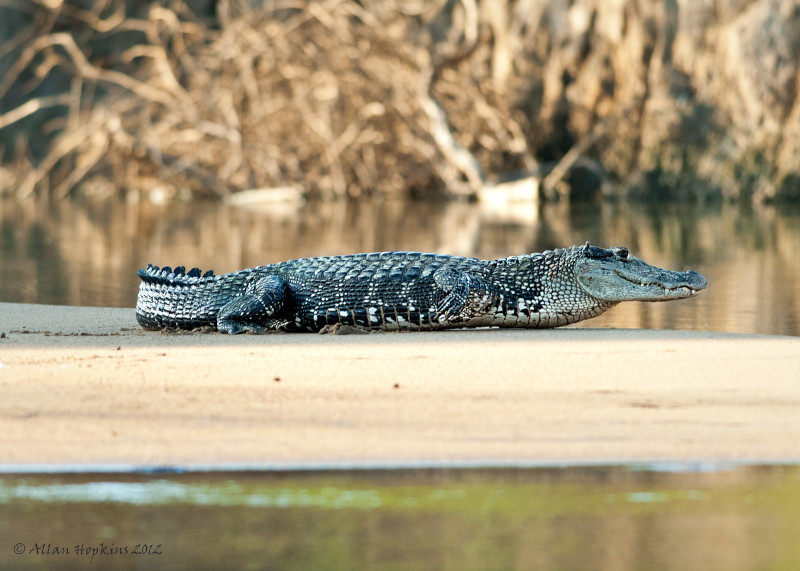
Black Caiman Facts
- For understandable reasons, this gorgeous reptile is most often referred to by the english language common name of the Black Caiman. It nonetheless has other general titles. These include such terms as melanic caiman and large caiman, among others.
- Inside of the scientific community, however, it’s perhaps better known by its techinical moniker. Unfortunately for the layperson, that’s a somewhat difficult term to pronounce. That’s because the animal holds the official epithet of Melanosuchus niger.
- The reptile received that tag due to the efforts of Johann Baptist Ritter von Spix. This respected German biologist accomplished the first recognition of the animal as a separate and distinct species. He managed that noteworthy feat in 1825.
- Sadly, the amazing animal currently faces a multitude of threats to its continued existence as a species. Chief among these is the fact that it’s still hunted by humans. The primary purpose of this continues to be for its flesh and the leather it provides.
- Due to this, the Black Caiman previously held the status of Endangered in the 1970’s. Conservation efforts did help with this somewhat. As a result, it presently holds a unique status with the IUCN. That’s the listing of Lower Risk/conservation dependent.
- Yet, this marvel of Nature and evolution also faces the same potential dangers as all species on earth today. The majority of those stem from the actions of mankind. They include the closely related dangers of habitat loss and ongoing climate change.
Related Articles
Black Caiman Physical Description
The remarkable Black Caiman almost immediately captivates those fortunate enough to encounter it. Unlike some reptiles, however, it does so for more than one reason alone. That’s because it’s not just a beautiful animal, but it also boasts an impressive size.
In terms of this aspect of its nature, it follows a pattern common among many creatures. That’s in the fact that it displays a certain degree of the physiological characteristic of sexual dimorphism. In its case, males attain greater average lengths and masses than the females.
The referenced males reach a mean head-and-tail length ranging from 16 – 20 ft (5 – 6 m). Weights, meanwhile, range from an incredible, 1,543 – 2,204 lb (700 – 1,000 kg). Amazingly, exceptional specimens sometimes exceed both of these measurements slightly.
Their female counterparts, though, remain significantly smaller in both dimensions. For them, an average total length only equals the comparatively tiny size of 10 – 13 ft (3 – 4 m). In terms of mass, this gender only attains a mean of around 881 – 1,102 lb (400 – 500 kg).
The animal also has a robust and muscular body, well-adapted for life in the water. That body also has a covering of thick, armored scales, providing protection from predators and other threats. The head of the reptile is also large and broad, with a long, powerful snout.
Its eyes and nostrils are located on the top of the head, allowing the powerful product of evolution to see and breathe while mostly submerged. It additionally has long, sharp teeth, particularly prominent in its upper jaw. The tail develops as highly elongated and muscular.
Yet, it’s perhaps the coloring of the Black Caiman that garners the most interest. As that term suggests, the animal possesses dark-colored skin. This tends to range from olive-brown to nearly black in adults. Juveniles, however, often have a lighter color, with spots or bands.
- Kingdom: Animalia
- Phylum: Chordata
- Class: Reptilia
- Order: Crocodilia
- Family: Alligatoridae
- Genus: Melanosuchus
- Species: M. niger
Black Caiman Distribution, Habitat, and Ecology
The breathtaking Black Caiman evolved as native to only a moderate portion of the surface of the earth. Yet, the precise location of that zone of habitation might surprise some of you. That’s because this marvel of evolution developed as native to parts of South America.
Even within that greater region, however, it primarily inhabits the extraordinary Amazon Basin, and its surrounding areas. This includes the Amazon River. Its distribution includes countries such as Brazil, Colombia, Ecuador, Peru, Venezuela, Guyana, and Bolivia.
This creature displays strong preferences for its choice of habitat, with some flexibility built in. That’s due to the fact that it appears in a variety of such within its range, though all must meet one basic requirement. That’s the simple fact of being of a freshwater nature.
The animal frequently makes its home in areas of slow-moving rivers and streams. It also enjoys oxbow lakes, formed when a river changes course and leaves behind a curved body of water. Other often favored regions include swamps, marshes, and flooded forests.
The mighty crocodilian represents an apex predator in its environment. Like its relatives, it also has an entirely carnivorous diet. In its case, this further qualifies as quite generalist in nature, meaning it consumes virtually anything that comes within its reach.
Certain prey items do tend to predominate in the diet of the Black Caiman, however. This occurs due to various factors, such as age, size, habitat, and availability of prey. Chiefly, though, these include various species of fish, amphibians, birds, mammals, and reptiles.
Following mating, females build nests made of vegetation to place their eggs in. These typically appear close to water to provide suitable conditions for the hatching of the eggs. After laying these, she guards the nest to protect it from predators until they emerge.
Species Sharing Its Range
Check out our other articles on 3 Tantalizing North Carolina Trees, Cape Porcupine, Great Barrier Reef, Great Rhododendron, Pom-pom Crab, Red Wood Ant, Rose’s Ghost Frog, Hyacinth Macaw
